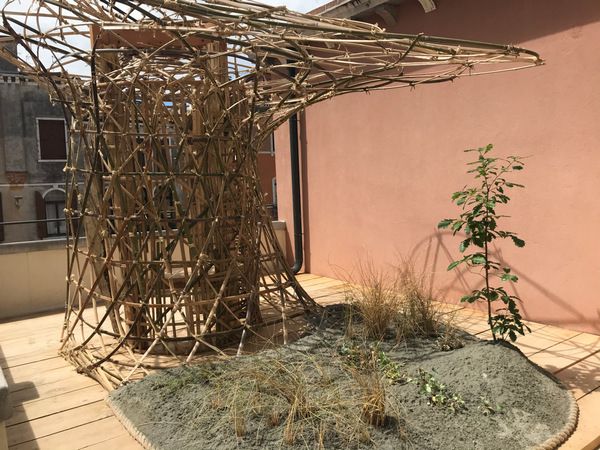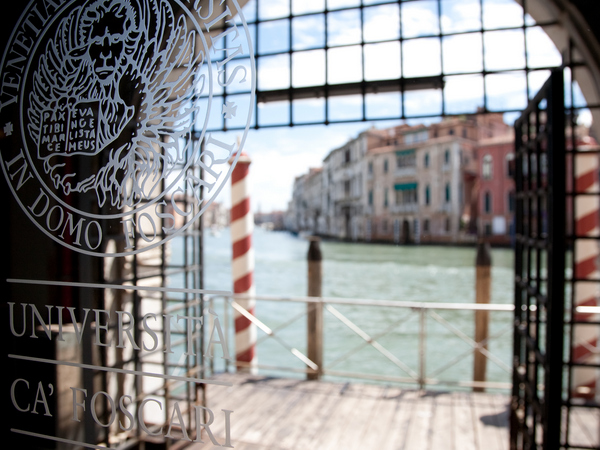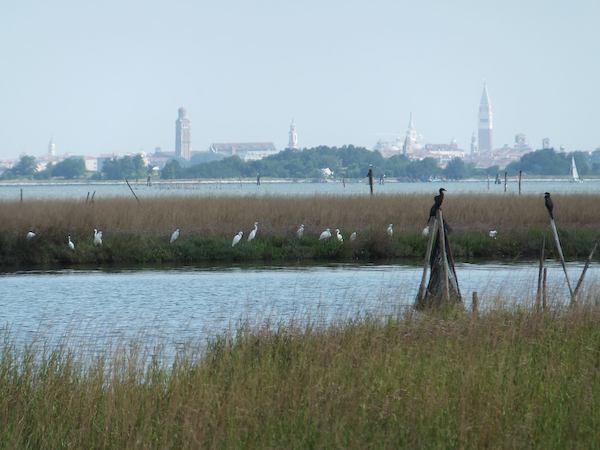Architecture, art, and science are often regarded as different fields, but thanks to creativity, vision, and technical rigour, they can meet, converse and encourage serious reflection. This is the case of Progetto Giardino (“Garden Project”), which is the product of a collaboration between Ca’ Foscari University of Venice and Tono Mirai, a Japanese architect who is presenting his work "Foresta Rigenerativa - JINEN" (“Rebirth of Forest – JINEN) in the Italian European Cultural Centre in the context of the exhibition “Time Space Existence" (21 May - 21 November) in the Venice Biennale.
For the city of Venice, Tono Mirai has translated the complex concept of Jinen (“ocurring itself”) into an installation of raw earth. The installation encourages viewers to reflect on a lifestyle in perfect harmony with nature, something that the origins of Japanese culture have in common with all human civilizations. The work of art is a structure made with natural materials: earth, wood, and bamboo symbolise the city of Venice, while a garden represents the Venitian ecosystem. Progetto Giardino has been made in collaboration with Ca’ Foscari University of Venice and Green Wise Italy, to create a small Venetian forest in JINEN.
Tono Mirai and Ca’ Foscari share an interest in common themes: the attention to the environment and the use of raw earth in “circular architecture” as a solution to global issues are dear to Tono Mirai, and his approach has merged with the research on ecosystems, environmental protection, and the study of natural systems for recycling, which for several years now have characterised some of the research conducted at Ca’ Foscari.
Gabriella Buffa, Professor of Botany at the Department of Environmental Sciences, Informatics and Statistics, is responsible for the Life REDUNE project, which is financed by the European Commission. The project aims to recover the Veneto coastline and preserve its biodiversity and dune ecosystems.The two projects, one artistic and architectural, the other involving scientific research, are in perfect unison: in fact, the plants which are studied by Professor Buffa are the very same plants used by the architect Tono Mirai in the exhibition. When the exhibition is over, the plants will be returned to the dunes.
Dune ecosystems on the Veneto coast are essential for coastal safeguarding. However, these ecosystems are endangered, having suffered a long history of exploitation and inappropriate management, which have resulted in a loss of habitat, in the loss of natural landscape patterns, in the diffusion of invasive species, in a growing threat to native species, and in a loss of resilience by plant communities and by the entire system.
The LIFE Redune project was launched to restore dune habitats and to maintain the ecological integrity of the ecosystem along the Veneto coastline, also through environmental education and events for tourists and operators. Dune plants are produced and cultivated for a period of time at the Veneto Agricoltura plant nursery, which is one of the research partners of Ca’ Foscari (together with Veneto Region – Regional Strategy of Biodiversity and Park Structure, SELC Società Cooperativa, Veneto Agency for Innovation in the Primary Sector, EPC - European Project Consulting s.r.l.). The plants are then planted on the dunes.
“There are many themes and concepts that connect Tono Mirai’s work with my research,” says Gabriella Buffa. “The first is the notion of jinen, an Oriental concept that means “ocurring itself”, that expresses the strength of nature. Nature is born of itself, without the intervention of external forces: neither humans, nor other entities produce it and enable its growth. At the same time, this concept underlines the importance of nature and the absolute need for us to regain our relationship with it: this must start with knowledge. In my field of studies, “nature” means “ecosystems”, so we must start with the knowledge of ecosystems and of the laws that govern their functioning, as well as their dynamics over time. It is only by means of this knowledge that we can achieve respect for nature, so that we can obtain what we call “goods and ecosystem services” that are at the base of human wellbeing.
The concept which most stimulated me is that of “tokowaka” (“always young”): the notion of circular life, of regeneration. This notion immediately created a link with LIFE Redune, one of the most important projects I have been working on in recent years. LIFE Redune is co-financed by the European Commission and its objective is to rebuild sections of the Venetian sand coastline to restore functionality to the system.”
Coastline sand ecosystems are among the most extraordinary examples of regenerative power – a concept that ecology translates as “resilience”, or an ecosystem’s ability to return to its original state after having been subjected to modifications.
Dune ecosystems are extremely interesting from an ecological perspective, given that they are systems that originate from a balance among the forces of nature: sea currents, tides, sand, wind, and plants. Plants are a fundamental component, without which dune ecosystems could not exist. In fact, plants make the wind slow down and trap sand with their stems and roots, thereby initiating the physical process of dune formation. It is precisely this dynamic balance of sand, wind and plants that causes dunes to “self-generate” and continually regenerate. During sea storms, dunes are partially eroded, but in this way they reduce the strength of the sea, protecting the inland whilst returning sand to the beach again. So the dune formation process can begin again.
Dune ecosystems are also a prime example of “waste” recycling. Normally, the debris that is washed onto the seashore during winter is considered waste and is periodically removed by means of tractors and buckets. However, trunks and seaweed that are washed onto the seashore are recycled by plants as an invaluable nutritional resource, given that nutrients are generally in very short supply in these natural systems. Trunks and seaweed are also used as a “skeleton” that reinforces the base of the dune and therefore makes it stronger.
Natural systems such as dunes, and the historic centre of Venice, where Tono Mirai’s work of art is exhibited, may seem very different environments. However, they share “tourist pollution”, as the presentation of Mirai’s work of art states. Tourist pollution involves an intense type of tourism, which is often rapacious and does not understand nor recognise the frailty of the two systems. In other words, it is an unsustainable form of tourism. Urbanisation, mechanical cleaning of seashores, and uncontrolled trampling cause the system to lose its vitality. Without plants, dunes become simple mounds of sand that are destined to be blown away by wind or washed away by the waves.
“In the 1950s at Alberoni there were dunes up to 10-12 metres high,” adds Gabriella Buffa. “In 1990, in the Veneto region, there were 350 hectares of dune systems, composed of the dune strip closest to the shore and of the retro-dunal strip, all the way to the pinewood. Almost 30 year later, in 2018, at Alberoni there were almost no traces of dunes or vegetation. The surface occupied by dunes has dropped to fewer than 270 hectares, which is a loss of 23%.”
The plants that occupy the space around the work of art are native species typical of the Venetian dunes. These plants have been produced for the REDUNE project and are used to rebuild the dune systems of the Venetian province. The plants will remain in the little “garden” that sits next to the work of art for the rest of the summer but, in keeping with the project’s aim to reuse all the material involved, they will be moved to one of the REDUNE sites once the exhibition is over.
Progetto Giardino will record the growth of the plants during the exhibition and their return to the dunes at the end. The resulting documentary will be widely shared in national and international events. The exhibition will also feature events, workshops and conferences on the topic of this “regenerative Venetian forest”.
About Tono Mirai
Tono Mirai is a Japanese architect born in Sendai. In his quest for building materials that would respect humankind and the environment, he encountered a traditional material, raw earth. Tono Mirai has been contributing for over 20 years to education and ecology by proposing earth architecture as a solution for the planet’s future. He has been awarded many national and international prizes for his work, which is modern in concept and organic in form.











